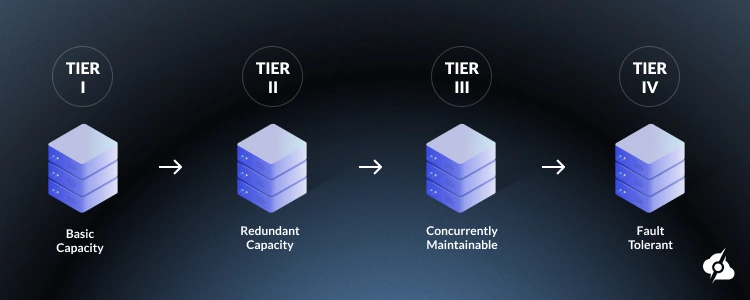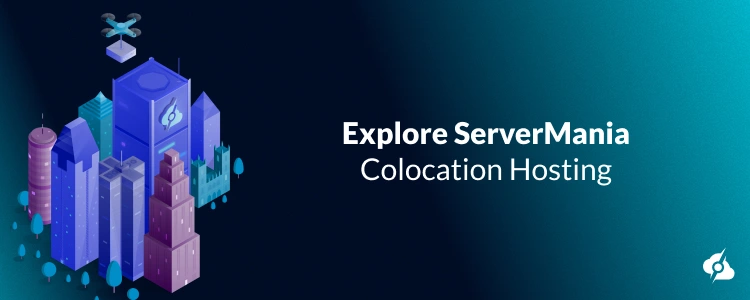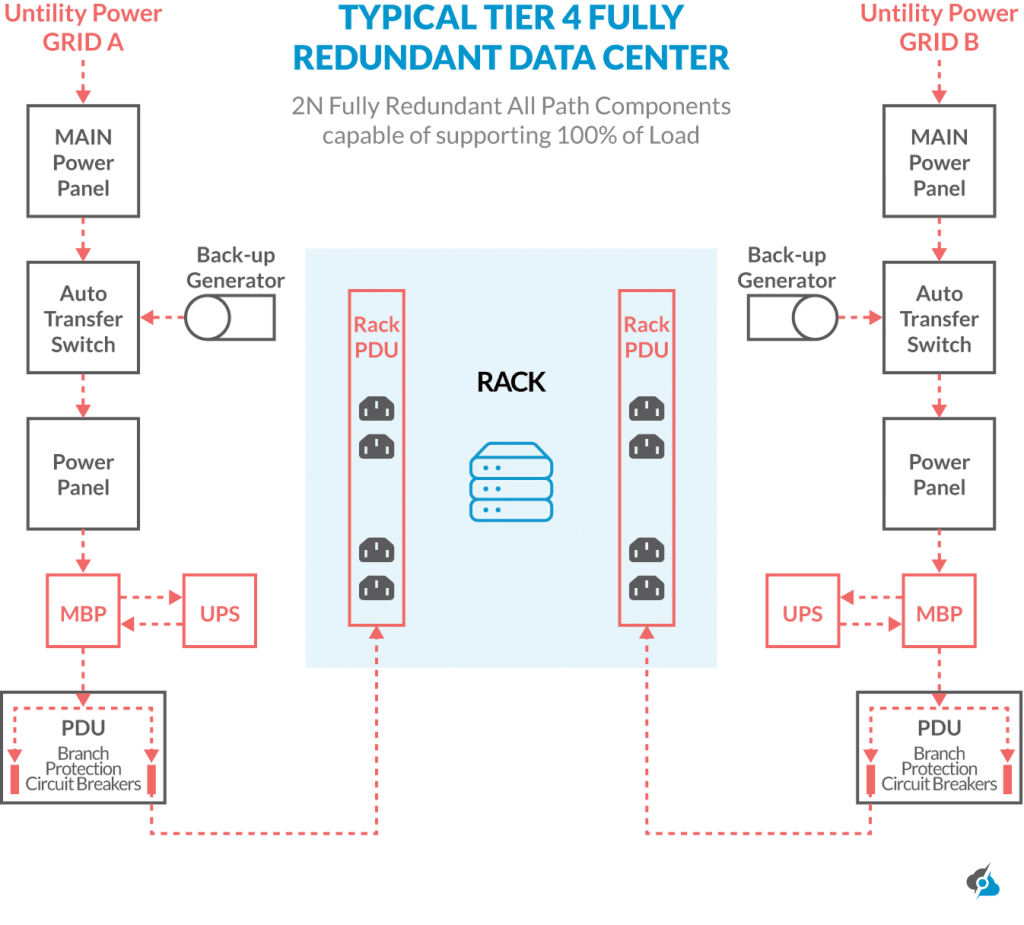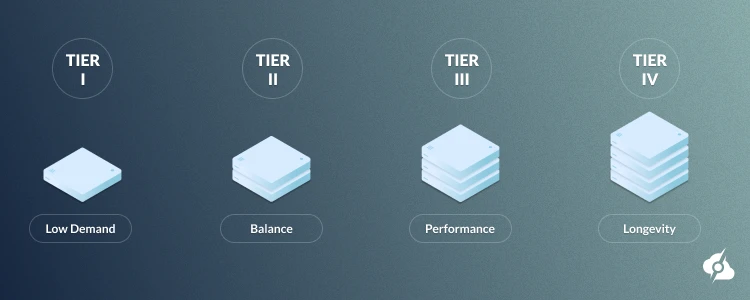Data Center Tiers Explained? Tier 1, 2, 3 and 4 – Everything You Need to Know

Data Center Tiers, established by the Uptime Institute, are the best way we have to determine how reliable a data center’s infrastructure is. They highlight a facility’s ability to keep operations smoothly, even when unexpected issues arise, by focusing on its redundancy and resilience.
Here at ServerMania we support our customers with data centers based on strategic locations such as New York, Los Angeles, London, Montreal, Vancouver and Amsterdam.
These Tier IV data centers provide lightning-fast connections to global networks, ensuring your business stays linked to the world. We also offer colocation in these facilities for businesses who want to benefit from robust data center infrastructure without the upfront investment.
In this guide, we will break down what each data center tier represents, helping you choose the ideal dedicated or cloud server hosting facility for your company’s needs.
See Also: ServerMania Data Centers Overview
Data Center Tiers Explained:
In short, a data center is a secure, physical space where businesses store their physical servers or vital applications and data. It’s the foundation of your operations, the hub where your servers operate, managing everything from data storage to daily challenges and the flow of information.
Data centers not only protect your operations—they keep your digital systems running smoothly and allow your business to grow. Without a data center, your operations would most-likely face low speeds and high risk, causing your productivity and security to decrease.
There are different types of data centers, each corresponding to a specific tier from 1 to 4. Each of these tiers represents different levels of redundancy and resilience.

Ultimate Data Center Tiers Comparison:
| Tier I | Tier II | Tier III | Tier IV | |
| Uptime | ~99.671% | ~99.741% | ~99.982% | ~99.995% |
| Downtime | <28.8 hours | <22 hours | <1.6 hours | <26.3 minutes |
| Redundancy | None | Partial (N+1 for power/cooling) | Full N+1 | Fault tolerant (2N or 2N+1) |
| Distribution Paths | 1 | 1 | 1 active + 1 alternate | 2 simultaneously active |
| Critical Power Distribution | 1 | 1 | 2 simultaneously active | 2 simultaneously active |
| Concurrently Maintainable | ❌ | ❌ | ✅ | ✅ |
| Fault Tolerance | ❌ | ❌ | ✅ | ✅ |
| Continuous Cooling | ❌ | ❌ | ❌ | ✅ |
| Price | 💲 | 💲💲 | 💲💲💲 | 💲💲💲💲 |
| Staffing | None | 1 shift | 1+ shifts | 24/7/365 |
| Typical Customer | Small companies, startups | Small to medium businesses | Growing and large businesses | Government, large enterprises |
| Why Choose This Tier? | The most affordable option(budgeting) | Balances cost and performance | High performance with affordability | Fault-tolerant for high-traffic demands |
Already have privately-owned hosting equipment?
ServerMania’s colocation hosting enables you to house your servers in a secure location, for ultimate performance and redundancy.

Tier I Data Center
TheTier I data centers represent the most fundamental level of infrastructure as defined by the Uptime Institute. It is designed only for basic operations, it lacks redundant systems, making it susceptible to downtime during planned maintenance or unexpected disruptions. This tier suits businesses with minimal IT demands where the budgeting is a priority over constant availability.
| Tier I Data Center Core Specifications | |
| Uptime Guarantee | 99.671% (up to 28.8 hours of downtime per year) |
| Power | Single, non-redundant power connection |
| Cooling | Dedicated cooling equipment, no redundancy |
| Fuel Storage | 12 hours of on-site fuel |
| Redundancy | None |
| Concurrently Maintainable | No (requires shutdown for maintenance) |
| Fault Tolerance | No |
Advantages & Disadvantages
Tier I data centers offer unique benefits but come with severe limitations:
Pros:
- Cost-Effective: Lower construction and operational costs make it the most affordable option amongst other data center Tier options.
- Simple Setup: Quick and straightforward infrastructure that is easy to manage, making it ideal for small-scale business needs.
- Basic Demand: Meets the demands of businesses and organizations with minimal reliance on constant uptime.
Cons:
- Downtime Risk: Vulnerable to interruptions during maintenance or failures, impacting business operations and availability.
- No Redundancy: Lack of backup systems increases the risk of data loss or service disruption during unplanned outages.
- Limited Scalability: Not designed for businesses or organizations expecting significant growth or heavy IT loads.
Tier I Data Center Use Cases
Tier I data centers are best suited for scenarios where constant access isn’t critical, such as:
- Data Backups: Storing archival or cold data that doesn’t require frequent retrieval, or daily access.
- Small Demand: Hosting basic websites, email servers, or internal tools for startups that do not have heavy traffic.
- Development: Supporting non-production systems where occasional downtime is not a problem and is acceptable.
In short, for businesses with light workloads or tight budgets, a Tier I data center offers practical, low-cost solutions. However, if your operations demand higher reliability or scalability, exploring higher tiers may better align with your goals.
Tier Il Data Center
A Tier II data center, as classified by the Uptime Institute, builds on Tier I by adding redundant components to enhance reliability. While it still relies on a single distribution path for power and cooling, it includes backup systems like generators and uninterruptible power supplies (UPS), making it more resilient to disruptions.
| Tier Il Data Center Core Specifications | |
| Uptime Guarantee | 99.741% (up to 22 hours of downtime per year) |
| Power | Redundant power (e.g., engine generator or fuel cells) |
| Cooling | Redundant chillers, heat distribution, and dedicated cooling |
| UPS | Redundant modules |
| Fuel Storage | 12 hours of on-site fuel for N capacity |
| Redundancy | Partial (N+1 for power and cooling) |
| Concurrently Maintainable | No (distribution path maintenance requires downtime) |
| Fault Tolerance | No |
Advantages & Disadvantages
Tier II data centers offer a balance of reliability with limitations you must consider:
Pros:
- Improved Reliability: The Tier ll data centers redundant components like generators and UPS reduce the risk of failure compared to Tier I.
- Budgeting Upgrade: Tier ll offers better uptime than Tier I without the high costs that naturally come with higher tiers.
- Partial Maintenance: Individual components can be serviced without any downtime, supporting operational continuity.
Cons:
- Single Distribution Path: Maintenance or failure of the power/cooling path can cause inevitable server downtime.
- Scheduled Downtime: Annual maintenance typically requires shutdowns, impacting availability and operation.
- Limited Fault Tolerance: Tier ll lacks full protection against simultaneous failures, unlike higher data center tiers.
Tier Il Data Center Use Cases
Tier II data centers are ideal for businesses that need better reliability than Tier I but can tolerate occasional downtime, such as:
- Medium Demand: Ideal for small websites, customer management systems, or internal applications with moderate uptime needs.
- Backup Systems: Storing secondary data or disaster recovery setups that don’t require constant access, or modification.
- Growing Startups: Tier II data centers support expanding IT needs without committing to premium infrastructure costs.
We can conclude that a Tier II data center is a practical balance between cost and performance, making it a smart choice for businesses needing enhanced reliability without a very high budget.
If your operations can handle minimal planned downtime, this tier offers solid value. For those requiring near-constant uptime, consider exploring Tier III or IV facilities.
Tier III Data Center
A Tier III data center offers a significant improvement in reliability over lower tiers by combining redundant components with multiple independent distribution paths for the power and cooling.
Tier III, designed for businesses that require availability, it allows maintenance without disrupting operations, making it ideal for 24/7 operations with minimal tolerance for downtime and outages.
| Tier IlI Data Center Core Specifications | |
| Uptime Guarantee | 99.982% (up to 1.6 hours of downtime per year) |
| Power | Redundant power (e.g., engine generator or fuel cells), multiple independent distribution paths |
| Cooling | Redundant chillers, heat distribution, and dedicated cooling |
| UPS | Redundant modules |
| Fuel Storage | 12 hours of on-site fuel for N capacity |
| Redundancy | Full N+1 |
| Concurrently Maintainable | Yes (maintenance without downtime) |
| Fault Tolerance | No |
Advantages & Disadvantages
Tier III data centers provide reliability but come with trade-offs that you need to be aware of:
Pros:
- High Availability: Tier III provides 99.982% uptime, which ensures minimal disruptions, ideal for critical operations.
- Full Maintainability: With Tier III, maintenance on any component or path can occur without affecting services.
- High Performance: Tier III, offers strong reliability without the premium cost that comes with the highest Tier IV data centers.
Cons:
- High Cost Allocation: Tier III is significantly more expensive than Tiers I and II due to advanced infrastructure.
- No Fault Tolerance: Tier III can’t withstand simultaneous failures, unlike the redundant infrastructure of Tier IV.
- Complex Management: The Tier III data centers require more sophisticated oversight when compared to lower tiers.
Tier IlI Data Center Use Cases
Tier III data centers are well-suited for businesses that prioritize high uptime and operational continuity, such as:
- E-commerce Platforms: Tier III data centers fully support online stores with consistent traffic and transaction needs.
- Enterprise Applications: Tier III can seamlessly handle hosting customer relationship management (CRM) or enterprise resource planning (ERP) systems.
- Healthcare Applications: Managing patient data or medical applications that require reliable access without downtime or interruptions.
A Tier III data center is a strong choice for businesses needing near-constant uptime and the ability to perform maintenance without interruptions. While it comes at a higher cost than Tiers I and II, it offers excellent reliability for growing or established organizations.
If your business requires full fault tolerance, consider exploring a Tier IV facility.
Tier IV Data Center
A Tier IV data center, such as our London UK Tier IV facility, represents the pinnacle of data center infrastructure. With fully redundant, independent, and compartmentalized systems, it offers unmatched reliability and fault tolerance.
Designed for mission-critical operations, Tier IV ensures continuous availability, even during catastrophic events, making it ideal for enterprises where downtime is unacceptable.

| Tier IV Data Center Core Specifications | |
| Uptime Guarantee | 99.995% (up to 26.3 minutes of downtime per year) |
| Power | Redundant power (e.g., engine generator or fuel cells), multiple independent distribution paths |
| Cooling | Redundant chillers, heat distribution, and dedicated cooling |
| UPS | Redundant modules |
| Fuel Storage | 12 hours of on-site fuel for N capacity |
| Redundancy | Fault tolerant (2N or 2N+1) |
| Concurrently Maintainable | Yes (maintenance without downtime) |
| Fault Tolerance | Yes (withstands single catastrophic event) |
| Compartmentalization | Yes (physically isolated systems) |
Advantages & Disadvantages
Tier IV data centers deliver unparalleled reliability but require careful consideration due to their cost and complexity:
Pros:
- Maximum Reliability: The Tier IV data center 99.995% uptime ensures near-constant availability for critical operations.
- Full Fault Tolerance: A Tier IV data center can withstand a single catastrophic failure without service disruption.
- Full Maintainability: The highest tier data center maintenance on any system or path occurs without impacting operations.
Cons:
- Very High Cost: This is the most expensive tier due to advanced infrastructure and ultimate system redundancy.
- Overkill for Some: Data center Tier IV often exceeds the needs of businesses without mission-critical requirements.
- Complex Operations: Requires sophisticated management and expertise to maintain, manage and operate.
Tier IV Data Center Use Cases
Tier IV data centers are tailored for enterprises with zero tolerance for downtime, such as:
- Financial Institutions: Supporting high-frequency trading or banking systems requiring uninterrupted access.
- Global Enterprises: Hosting mission-critical applications like ERP or supply chain management systems.
- Government and Healthcare: Managing sensitive data or critical services, such as patient records or national infrastructure.
In short, a Tier IV data center is only required when businesses can’t tolerate downtime, offering unmatched reliability. The cost justifies its advanced infrastructure capabilities, which makes it a good investment for mission-critical operations.
Choosing a Data Center Tier for Your Business
Selecting the right data center tier is crucial for your business in order to maximize efficiency in regard to budget, intentions and longevity.
While each tier has unique pros and cons, your decision should align with your specific needs, so below we’re going to unwrap factors by their priority.

Continuity and Downtime
Most-importantly, you need to consider how much downtime your business can handle. For operations that must stay online 24/7, like e-commerce or critical services, Tier III or IV data centers provide the high uptime needed to avoid costly disruptions.
Redundancy Requirements
The next thing to take into an account is the backup systems your business requires to operate smoothly. Tier I and II data centers lack the redundancy that is required for continuous power and cooling, while Tier III and IV offer multiple layers of backup.
Scalability and Flexibility
You must plan for your business’s growth. Higher-tier data centers (Tier III and IV) are built to handle scalability with infrastructure that supports upgrades and maintenance without downtime. If your IT requirements will grow over time, investing in a higher tier can save future headaches.
Budget and Investments
Higher tiers naturally come with high prices because of the advanced systems and redundancy. Weigh the costs against your budget and the value of uninterrupted service. Choosing a tier that balances affordability with your operational needs is key to a smart investment.
Compliance and Security
If your business operates under strict regulations, such as HIPAA or GDPR, you must prioritize data centers with robust security measures and compliance certifications. Tier III and IV facilities typically offer protections like biometric access and isolated systems meeting security demands.
Data Recovery Capabilities
Evaluate how well a data center can withstand disasters, from power outages to natural events. Higher-tier data centers, especially Tier IV, are designed to keep operations running even during significant disruptions, offering peace of mind for critical systems.
Energy Efficiency and Impact
For businesses prioritizing sustainability, a data center’s energy efficiency matters. So, look for facilities with modern cooling systems or renewable energy, as they reduce the environmental impact and long-term costs, particularly in higher tiers.
Technical Support & Services
Reliable support can make or break your data center experience. Partnering with providers like ServerMania, which offers expert technical assistance and managed services, ensures your infrastructure runs smoothly and issues are resolved quickly.
At ServerMania, we partner with Tier 3 and Tier 4 data centers to ensure maximum uptime for our customers. We also offer a 100% network uptime SLA to host even the most mission critical business applications.
Book a free consultation today and find out how ServerMania Tier 3 and Tier 4 data centers can empower your business.
Was this page helpful?

